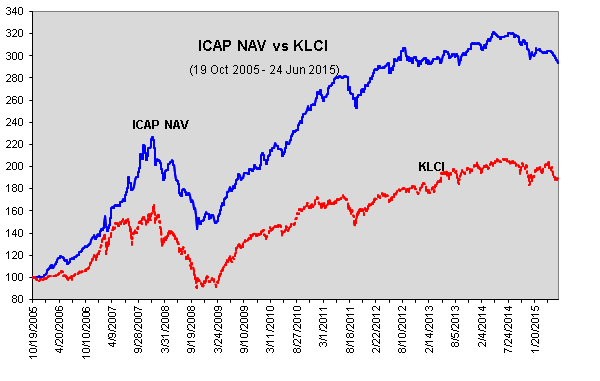INVESTMENT
PORTFOLIO of iCAP
As of
31 May 2017, your Fund has not invested in unlisted investments
and all other investments apart from securities listed on Bursa Malaysia
Securities Berhad. The investment objectives and policies of your Fund
have been consistently applied to its investment portfolio.
Details of the investment portfolio of your Fund are as follows :-
Companies .... Shares .... Cost
(RM) ....Value (RM)
....Impairment Loss
(RM) .... Unrealised Profit/
(Loss) (RM)
1 APM Automotive Holdings Berhad.... 1,420,500.... 5,306,991.... 5,838,255
.... - .... 531,264
2 Boustead Holdings Berhad ....12,147,786.... 27,444,475 ....32,191,633
.... - .....4,747,158
3 Fraser & Neave Holdings Berhad ....517,600 ....3,923,846 ....12,588,032
.... - ....8,664,186
4 Malaysia Smelting Corp Berhad ....2,902,000 ....10,082,424 ....11,753,100
....
(2,392,124) ....4,062,800
5 MKH Bhd ....1,356,830.... 3,436,689 ....3,378,507
.... - ....
(58,182)
6 Oceancash Pacific Bhd.... 2,230,000 ....1,249,861.... 1,627,900
.... - .... 378,039
7 Padini Holdings Berhad.... 19,000,000 .... 5,490,389.... 66,690,000
.... - .... 61,199,611
8 Parkson Holdings Berhad ....10,742,298 .... 21,202,731 .... 6,176,821
....
(14,327,660) ....
*(698,249)
9 Selangor Properties Berhad ....1,666,400 .... 7,743,009 .... 8,282,008
.... - .... 538,999
10 Suria Capital Holdings Berhad ....9,244,400 .... 15,400,153 .... 19,690,572
.... - .... 4,290,419
11 Tong Herr Resources Berhad.... 2,579,300.... 6,045,732.... 9,388,652
....
(513,988) .... 3,856,908
Total
Cost
(RM) 107,326,299
Value
(RM) 177,605,480
Impairment Loss
(RM)
(17,233,772)
Unrealised Profit/
(Loss) (RM) 87,512,953
IMPAIRMENT LOSS
Parkson RM (14,327,660)
Tong Herr RM (513,988)
MSC RM (2,392,124)
Total RM (17,233,772)
As at 31 May 2017, impairment loss on investment in Parkson Holdings Berhad was RM14,327,660 due to decline
in market value of Parkson Holdings. The market value as at 31 May 2017 was RM6,176,821 and the cost was
RM21,202,731. This is considered significant under FRSIC issued Consensus 14 – Impairment of Investment in Equity
Instrument categorised as Available-for-Sale Financial Asset. A decline in fair value below the original cost of the equity
instrument that had persisted for more than 9 to 12 months would generally be considered as “Prolonged” and hence,
be impaired.
*As at 31 May 2017, the net unrealised loss for Parkson Holdings Berhad was RM698,249 together with the
impairment
loss of RM14,327,660 recognised as at 31 May 2017, giving the total unrealised loss of RM15,025,909.
For Tong Herr Resources Berhad and Malaysia Smelting Corporation Berhad, the impairment loss of
RM513,988 and
RM2,392,124 were made in the financial year 2014 and financial year 2015 respectively
DISPOSAL
This share was disposed during the financial year ended 31 May 2017
Tong Herr Resources Berhad
Shares 900,000
Cost (RM) 1,809,579
Disposal Value (RM) 1,744,242
Realised Loss (RM) 65,337
Description of the Companies
Businesses
APM Automotive Holdings Berhad
APM
Automotive is a Malaysian automotive
parts manufacturer that has expanded rapidly
to become a major regional supplier and is
expanding globally.
Boustead Holdings Berhad
Boustead Holdings is one of the largest
conglomerates in Malaysia, with business
spanning 6 sectors; namely, plantation, heavy
industries, property, finance and investment,
pharmaceutical, and trading and industrial.
Fraser & Neave Holdings Berhad
Fraser & Neave Holdings (F&N) is a leading
manufacturer and distributor of soft drinks and
dairy products under various brands. F&N’s
property division was formed to unlock the value
of its freehold properties in Klang Valley.
Malaysia Smelting Corporation Berhad
The MSC Group is currently one of the world’s
leading integrated producers of tin metal and
tin based products and a global leader in tin
smelting.
MKH Berhad
MKH is a well-known property developer.
Apart from property development, MKH has
ventured into other businesses such as oil palm
cultivation, furniture manufacturing and trading.
Oceancash Pacific Berhad
Oceancash Pacific is a manufacturer of
resonated and thermoplastic felts. The group
has expanded its range of product and services.
Padini Holdings Berhad
Padini is a leading retailer of its own fashion
labels through freestanding stores, franchised
outlets and consignment counters in Malaysia
and abroad.
Parkson Holdings Berhad
Parkson is a leading operator of department
stores in Malaysia, China, Vietnam, Indonesia,
etc.
Selangor Properties Berhad
Selangor Properties is involved in property
investment and development, and investment
holding.
Suria Capital Holdings Berhad
Suria Capital is the leading port operator in
Sabah. Apart from the port operations, the
group has ventured into other businesses,
including property development.
Tong Herr Resources Berhad
Tong Herr Resources is a leading manufacturer
of stainless steel fasteners and has expanded
into manufacture of aluminum extrusion
products in Malaysia.
Ref: 2017 Annual Report of iCAP
http://disclosure.bursamalaysia.com/FileAccess/apbursaweb/download?id=182076&name=EA_DS_ATTACHMENTS




